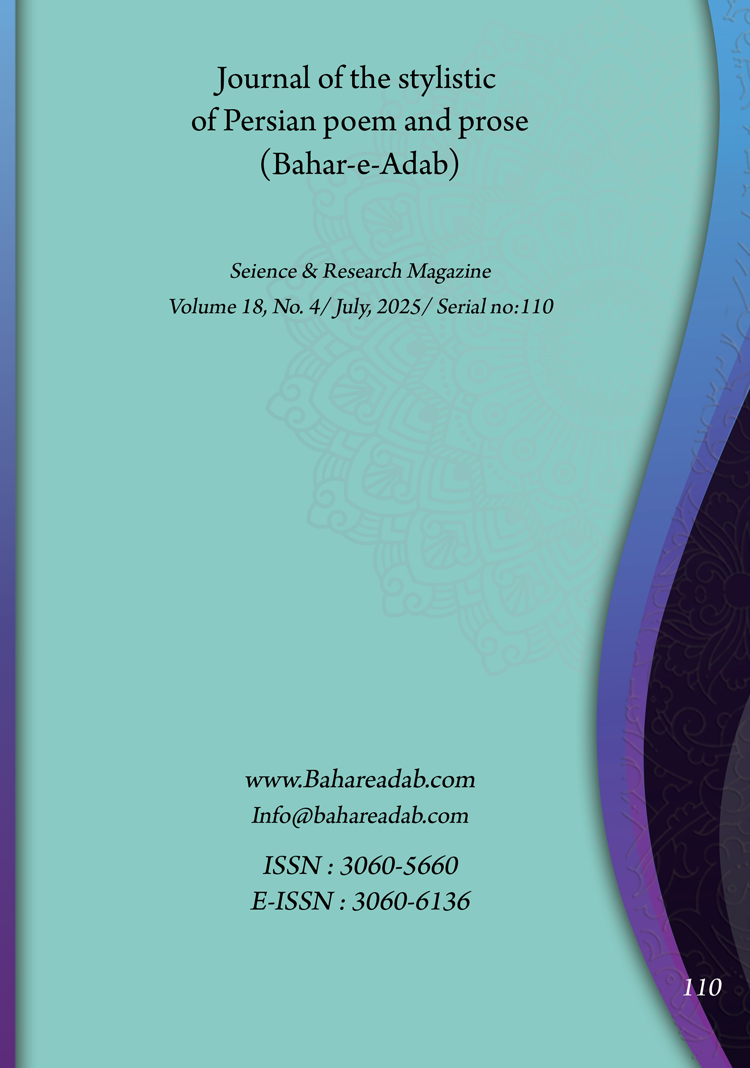- Count View : 47
- آدرس کوتاه شده مقاله: https://bahareadab.com/article_id/1839
- کد doi مقاله: Doi: 10.22034/bahareadab.2025 .18 .7829
Journal of the stylistic of Persian poem and prose
volume Number 18،
number In Volume 4،
،
issue Number 110
An Aesthetic Critical Study of Contemporary Iranian Women's Poetry in Resistance Literature (Case study: Sepideh Kashani, Simindokht Vahidi, Fateme Rakei and Tahereh Safarzadeh)
Atiyeh Nouri , Hojjatollah Gh Moniri (Author in Charge), Nahid Azizi
Abstract
BACKGROUND AND OBJECTIVES: The present study aimed to examine the poems of four contemporary Iranian women, namely Sepideh Kashani, Simindokth Vahidi, Fatemeh Rakei, and Tahereh Saffarzadeh, in the field of sustainability, based on aesthetics, and from this perspective, presents the characteristics of the artistic performance of the mentioned poets to the reader. In this regard, mainly aesthetic components based on the tools of imagination (simile, metaphor, discrimination, and symbols) have been considered.
METHODOLOGY: The research method in this study is descriptive-analytical based on library sources (primary sources and surrounding research).
FINDINGS: The findings show that the poets in this research have experimented in the field of poetry and have left valuable examples in this regard, so that these poems can be considered a historical-literary document of the bravery and courage of Iranian warriors during the hectic periods of the revolution (especially the period known as the Sacred Defense period). In addition, each of these women has performed in a way that is specific to their linguistic/literary style and has used the tools of literary imagination - which are mainly mentioned in the discussion of figurative language. Among them, simile, metaphor (= identification) and symbols have occupied the most devices and have used other devices such as: sensuality, paradox, etc. less. In addition, personalities such as Saffarzadeh and Rakei - respectively - have presented new and more pristine images on the screen of imagination, as required by free poetry.
CONCLUSION: The results of the research show that one of the intellectual themes of the mentioned poets is resistance to the tyranny of the times (domestic tyranny and foreign arrogance); among these four, some have embraced the theme of sustainability in the form of traditional poetry, and some have mainly addressed this issue in the form of prose poetry; since free verse or prose poetry has a better and greater opportunity for experimentation - with various means of literary imagination (imaginary images), Saffarzadeh and then Rakai have emerged in creating pristine and constructed images, modern (more innovative) and have overcome the task of describing and depicting the sacrifice and bravery of the warriors of the Eight Years" War.
Keyword
aesthetics
, poetry
, contemporary women orators
, sustainable literature
, Iran.
- Akbari, Manouchehr (1992), Criticism and Analysis of Islamic Revolution Literature, Tehran: Islamic Revolution Cultural Documents Organization.
- Emami, Nasraleh (1990), Elegy in Persian Literature, Ahvaz: Academic Jihad.
- Sarvatian, Behrouz (1990), expression in Persian poetry, Tehran: Barg.
- Rakei, Fatemeh (1990), Safar Sokhtan, Tehran: Raja Cultural Publishing Center.
- (1996), Avaz Golsang, Tehran: Information Publishing.
- Roozbeh, Mohammad Reza (2001), Contemporary Iranian Literature (Poetry), Tehran: Roozer Publishing.
- Sangri, Mohammadreza (2006), wandering in the shadow of the sun; Reflections on the categories of contemporary literature, second edition, Tehran: Loh Zarin.
- Shafiei-Kadkani, Mohammad Reza (1987), Surkhayal in Persian poetry, third edition, Tehran: Aghaz.
- Shamisa, Siros (1994), Bayan, 4th edition, Tehran: Ferdous.
- Safa, Zabihullah (1988), History of Literature in Iran, Tehran: Ferdous.
- Safarzadeh, Tahereh (2012), collection of poems, Tehran: Pars Kitab.
- Ghamoniri, Hojjatoleh (2017) The style of the poetry of stability (revolution and holy defense) with an emphasis on symbols, Literary Criticism and Stylistics Research Quarterly, No. 1 (series 31): pp. 203-228. https://journals.iau.ir/article_544481.html
- Kashani, Sepideh (1994), Sokhna Ashna, Tehran: Ministry of Culture and Islamic Guidance.
- (1373 B), Hazar Daman Gol-Sorh, Tehran: Surah Mehr.
- Kakaei, Abdul Jabbar (2008), Comparative Study of Sustainability Themes in the Poetry of Iran and the World, Tehran: Palisan.
- Kezazi, Jalaluddin (1993), Bayan (Esthetics of Persian speech), third edition, Tehran: Center.
- Homai, Jalaluddin (2005), Rhetorical Techniques and Literary Industries, 24th edition, Tehran: Homa.
- Vahidi, Simindakht (1995), One sky of an angel, Tehran: Surah Mehr.
- ------------------------ (1996 A), restless waves, Tehran: Hadith.
- ------------------------ (1996 B), I feel life, Tehran: Surah Mehr. 21. (1384), this people suddenly, Tehran: Surah Mehr.
- ------------------------ (2007), reaching the understanding of love, Tehran: Teka.

